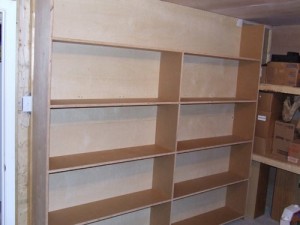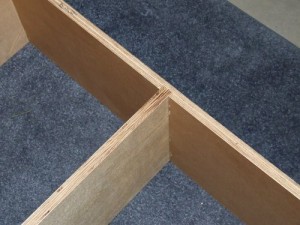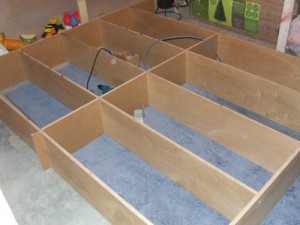How To Build A Bookcase
DIY Bookcase
 In this post I’ll show you how to build a simple bookcase. Bookcases can be as simple as this storage room bookcase or as elegant as a fine piece of furniture. There are many different ways to build a bookcase, this happens to be my preference typically.
In this post I’ll show you how to build a simple bookcase. Bookcases can be as simple as this storage room bookcase or as elegant as a fine piece of furniture. There are many different ways to build a bookcase, this happens to be my preference typically.
Bookcase Materials
For this bookcase I’m using 3/4″ thick MDO plywood. I like using MDO plywood because it paints really well and it’s nice to work with (cuts well, easy to layout and mark pieces, etc). For the back of the bookcase I used 1/4″ Sureply underlayment.
Dado Joints
 The joints for this bookcase are made with dados, glue and screws. Again, there are many different ways to build a bookcase but I want strong joints so I like to use dados. Cross-cutting dados on a table saw is very difficult so I like to use a router to cut dados in shelving material.
The joints for this bookcase are made with dados, glue and screws. Again, there are many different ways to build a bookcase but I want strong joints so I like to use dados. Cross-cutting dados on a table saw is very difficult so I like to use a router to cut dados in shelving material.
How To Build A Bookcase
For this bookcase I tried to keep all the material in 8′ lengths where possible. I have two side end pieces, 12″ wide and 8′ tall. I’ve cut dados on one side of each end piece to accept the horizontal shelves. As you can see in the adjacent photo the shelf fits into the dado that was cut in the side end piece.
 Next I cut five shelves, again 12″ wide and 8′ long. The shelves get a dado in the center, top and bottom to fit the vertical center supports into. You can’t really see in the photo, but the center vertical piece is actually short pieces that fit in between each shelf. I cut the dados in the shelves slightly shallower (3/16″) than the side pieces because I’m cutting on both sides.
Next I cut five shelves, again 12″ wide and 8′ long. The shelves get a dado in the center, top and bottom to fit the vertical center supports into. You can’t really see in the photo, but the center vertical piece is actually short pieces that fit in between each shelf. I cut the dados in the shelves slightly shallower (3/16″) than the side pieces because I’m cutting on both sides.
To assemble the bookcase I just fit it all together first to make sure it all fits well and to check that the dados were not too tight. The final step is to apply a thin layer of wood glue in each of the dados, fit the pieces together and screw it all together.
Once all the shelves and supports were screwed and glued I installed the 1/4″ plywood back. The key step here is to make sure the bookcase is square before attaching the back. I used 1″ long wood screws to attach the back to the bookcase. Then I stood up the unit and screwed it to the wall with 1 5/8″ wood screws to secure it so it won’t fall over.
I’ll leave this bookcase un-painted and un-finished because it’s in our basement storage room. However, you could easily finish this bookcase with a simple face frame. You could cut some 3/4″ thick pine, maybe 3″ wide or so and attach it to the face of the bookcase to create a nice finished appearance.
Tools You’ll Need
The following list of tools are very helpful in building a bookcase. The links will bring you to Amazon where you can buy them if you don’t already own them.
Delta 10 inch Contractor Table Saw
Porter-Cable Router
DeWALT Cordless Drill
Framing Square
Level













Good to know!
Good design, but the long shelf length will eventually sag due to the weight of the books, especially hardbacks. For plywood shelves, 32″-36″ should be about the maximum length unless you support the front edge of the shelf.
Is there a site that shows how to plan making a built-in bookshelf unit? Is there a pictorial view of using the plunge router to make the dado cut?
@ Doug – Feel free to email me questions. Cutting the dado’s is pretty easy once you lay everything out.
In the center vertical board, where there is a shelf on either side, how deep did you make the dados; how much material was left between the two shelves on the vertical board?
For instance, if using 3/4″ wood, and using a 1/4″ deep dado on each side, there would only be 1/4″ of thickness left in the vertical board.
Dave – Typically the rule of thumb is the dado is 1/3 the depth of the base material. If you’ve got a dado top and bottom you will likely want to total of both to be 1/3. So, 3/4″ plywood, I’d make them both about and 1/8″, maybe 3/16″, but they really don’t need to be deep. Good luck..
Looks good. I want to wall-mount mine so it “floats” above the baseboard. If I screw through the 1/4″ plywood backing into the studs, will that be strong enough to hold it (with heavy law books)? Also, I do want my final product to look very furniture-like. Can I achieve that with the plywood you describe, plus stain and poly?
I would NOT support it like that. The only way to do a floating one is with a more robust design.